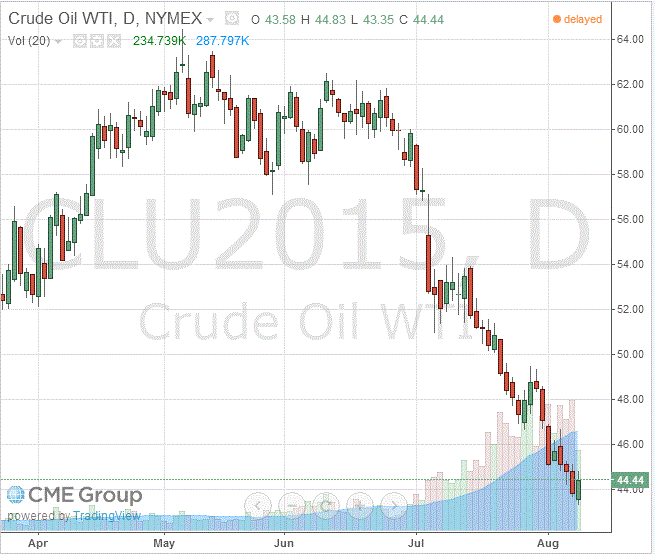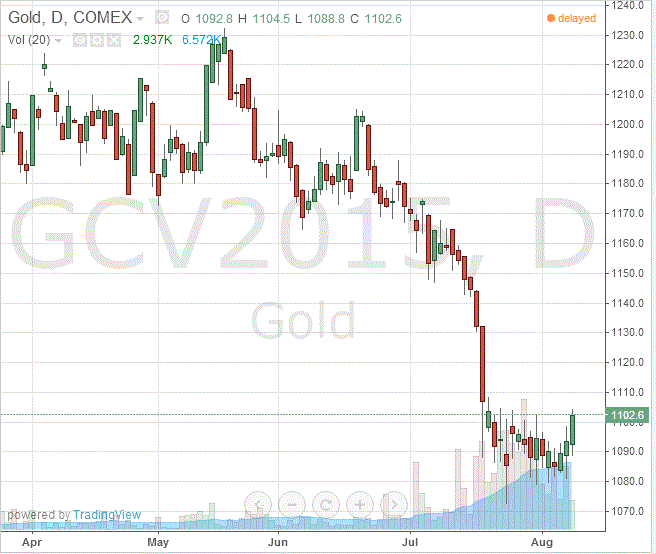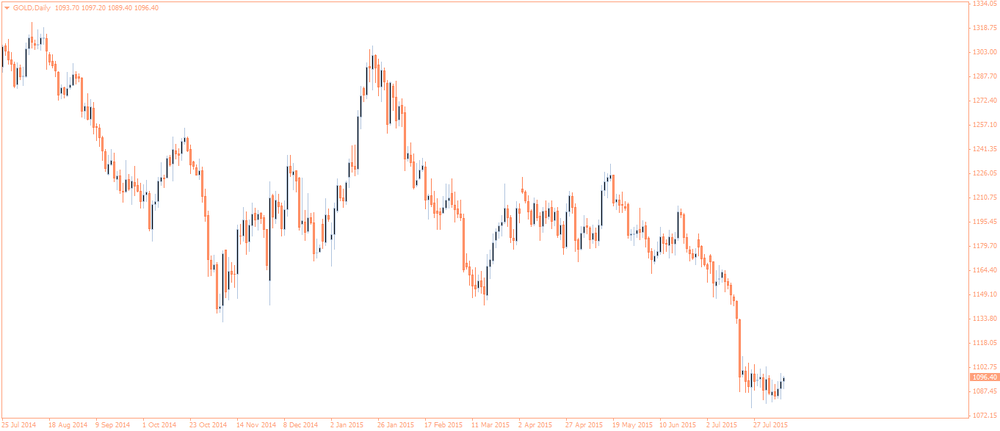Noticias del mercado
-
17:42
Oil prices increase on a weaker U.S. dollar and as Chinese stock market recovered
Oil prices increased on a weaker U.S. dollar and as Chinese stock market recovered. Oil prices dropped 7% last week on concerns over the global oil oversupply.
Earlier, the weak Chinese economic data weighed on oil prices. China's trade surplus fell to $43.03 billion in July from $46.54 billion in June, missing expectations for a rise to a surplus of $53.25 billion. Exports fell at an annual rate of 0.9% in July, while Imports slid at an annual rate of 14.6%, the ninth consecutive decline.
Investors eyed the number of oil rigs data. The oil driller Baker Hughes reported that the number of active U.S. rigs rose by 6 rigs to 670 last week. The increase was driven by a rise in rigs in the Permian basin. Combined oil and gas rigs climbed by 10 to 884.
WTI crude oil for September delivery climbed to $44.44 a barrel on the New York Mercantile Exchange.
Brent crude oil for September rose to $49.77 a barrel on ICE Futures Europe.
-
17:25
Gold rises on a weaker U.S. dollar
Gold traded higher due to a weaker U.S. dollar. Gains are limited as market participants speculate the Fed could start raising its interest rate in September.
Investors eyed comments by the Fed Vice Chairman Stanley Fischer. He said in an interview Monday on Bloomberg Television on Monday that inflation in the U.S. is very low, but is temporary. Fischer pointed out that inflation was low due to declines in oil prices and in raw materials.
October futures for gold on the COMEX today rose to 1102.60 dollars per ounce.
-
11:37
China's trade surplus declines to $43.03 billion in July
The Chinese Customs Office released its trade data on Saturday. China's trade surplus fell to $43.03 billion in July from $46.54 billion in June, missing expectations for a rise to a surplus of $53.25 billion.
Exports fell at an annual rate of 0.9% in July, while Imports slid at an annual rate of 14.6%, the ninth consecutive decline.
China's trade with the European Union declined by 7.6% year-on-year in the first seven months to 1.98 trillion yuan.
Trade with Japan plunged 11.1%, while trade with the US increased 2.7%.
-
10:59
People's Bank of China’s second-quarter monetary policy report: the exchange rate of the yuan should be kept at a reasonable level and should be more flexible
The People's Bank of China released its second-quarter monetary policy report on Friday. The central bank said that the country's economy is "still relatively reliant on policies intended to stabilize growth and on government-led investment".
According to the report, the monetary policy should be kept "appropriate", and the exchange rate of the yuan should be kept at a reasonable level and should be more flexible.
-
10:42
Number of active U.S. rigs rises by 6 rigs last week
The oil driller Baker Hughes reported that the number of active U.S. rigs rose by 6 rigs to 670 last week. The increase was driven by a rise in rigs in the Permian basin.
Combined oil and gas rigs climbed by 10 to 884.
-
10:25
China's foreign exchange reserves fall by $42.5 billion in July
China's foreign exchange reserves declined by $42.5 billion to $3.65 trillion in July. It was the lowest level since August 2013. The reason for the decline in reserves could be an economic slowdown in China and concerns over the crisis in the stock market.
The People's Bank of China release its monthly data for the first time. It was used to release the quarterly data.
China's gold reserves to $59.2 billion in July from $62.4 billion in June.
-
10:18
Chinese consumer price index rises at annual rate of 1.6% in July
The Chinese National Bureau of Statistics released its consumer and producer price inflation data for China on Sunday. The Chinese consumer price index (CPI) rose at annual rate of 1.6% in July, exceeding expectations for a 1.5% increase, after a 1.4% gain in May.
The increase was driven by rises in food and non-food prices. Food prices rose at an annual rate of 2.7% in July, while non-food prices increased 1.1%.
On a monthly basis, consumer price inflation increased 0.3% in July, after a flat reading in June.
The Chinese producer price index (PPI) dropped 5.4% in July, missing forecasts of a 5.0% fall, after a 4.8% decline in June. It was the biggest decline since October 2009.
-
09:02
Oil prices declined amid oversupply concerns
West Texas Intermediate futures for September delivery fell to $43.64 (-0.52%), while Brent crude dropped to $48.41 (-0.41%) amid oversupply concerns. Baker Hughes, an oil-field services company, reported that the number of U.S. drilling rigs rose to 670 (the third straight weekly gain).
OPEC continues to pump at record levels and Iran intends to raise its exports as soon as it's able to.
Meanwhile the U.S. seems to be getting closer to lifting its 40-year-ban on crude exports. U.S. authorities may vote upon the issue as early as September.
-
08:42
Gold stayed slightly above its 5-1/2 low
Gold is currently at $1,095.60 (+0.14%) slightly above a 5-1/2-year low. U.S. employment data matched optimistic expectations suggesting the Federal Reserve could raise interest rates in September. Higher rates would be harmful for the non-interest bearing bullion; although some analysts believe that a minimum increase in U.S. rates is considered in current prices of gold.
Holdings of SPDR Gold Trust, the largest gold-backed exchange-traded fund in the world, dropped further to 21.47 million ounces, the lowest level since September 2008.
-
00:39
Commodities. Daily history for Aug 7’2015:
(raw materials / closing price /% change)
Oil 43.55 -0.73%
Gold 1,092.30 -0.16%
-


